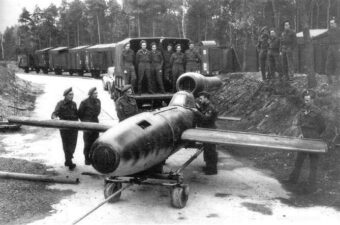“Unveiling the Bizarre: How Nazi Germany Crafted a Wooden Weapon of War That Defied Belief”
Wind-tunnel tests conducted at the Institute for Aerodynamics for Berlin in September 1944 revealed the design to be stable at speeds of up to 500 kilometres per hour, allowing preliminary development to proceed as planned. The first prototype, designated M1, was manufactured at Bachem’s new factory at Waldsee in the Black Forest and delivered in October 1944. Fitted with temporary landing gear and towed behind a Heinkel He 111 bomber, the aircraft was used for a series of captive glide tests. While the first four flights went perfectly, during the fourth the Natter became unstable, forcing test pilot Erich Klöckner to bail out. When it was determined that the tow cable and temporary landing gear had interfered with the craft’s aerodynamics, pilot Hans Zübert made a daring untethered gliding flight to prove the design once and for all. The aircraft performed perfectly, allowing the project to proceed with powered flights.
The first vertical, unmanned launch of the Natter took place on December 18, 1944 at Ochsenkopf near Württemburg. As the Walter rocket engines were not yet ready, the aircraft was powered only by the Schmidding boosters. Unfortunately, due to a design flaw in the launch tower, the aircraft crashed soon after liftoff. The next launch on December 22, however, was completely successful, as were the next 10 launches. In early 1945, the Walter engines finally arrived, and a full-up test launch with all engines and a dummy pilot was conducted on February 25. Once again the launch went perfectly, with the dummy being recovered intact. However, the residual propellants in the engine exploded on impact with the ground, destroying the rear fuselage.










